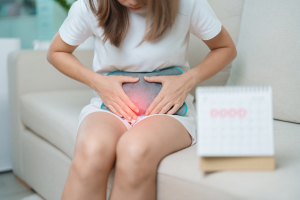Ovulation pain is a phenomenon that affects many women in the middle of their menstrual cycle. Although this is a natural condition, it can cause discomfort and anxiety.
Symptoms can vary greatly in intensity, duration, and nature. Some women complain of mild discomfort or a feeling of heaviness, while others may experience a more acute, stabbing pain. Typically, the pain is localized on the side depending on which ovary the oocyte is released from, but it can also radiate to the lower abdomen or lower back. Some women may experience cramps similar to menstrual cramps. Although this is unpleasant, it is usually not a sign of a serious medical condition.
Are there other symptoms that may occur?
The most common symptoms, other than one-sided pelvic pain, are:
• bloating;
• spotting vaginal discharge;
• nausea;
• chest pain.
It is important to note that not all women experience these symptoms, and their intensity can vary significantly from patient to patient.
How long does this last?
The duration of ovulation pain varies greatly among patients, but is usually quite short. The discomfort or pain may last for several hours or for one or two days. It is important to note that although ovulation pain usually goes away on its own, without the need for special treatment, if the pain is particularly severe or lasts longer than usual, it makes sense to consult a gynecologist at the Bogolyuby Medical Center to rule out other possible causes of abdominal pain.
What are the reasons?
The exact mechanism by which ovulation causes pain is not fully understood, but there are several theories. One suggests that the pain may be caused by the rupture of an ovarian follicle, a process that can stretch the ovarian lining and cause pain.
Another theory is that fluid or blood leaking from the ruptured follicle may irritate the peritoneum , the membrane that lines the inside of the abdominal wall.
How to relieve ovulation pain?
In most cases, ovulation pain does not require special treatment. However, if the discomfort is significant, there are steps you can take to ease it. Take over-the-counter pain relievers, apply local heat with a hot water bottle, or take a hot bath. Practice relaxation techniques such as deep breathing or yoga. In some cases, your gynecologist may prescribe birth control pills, which suppress ovulation and may reduce pain.
Are there any risks?
Although ovulation pain is usually not a cause for concern, in some cases, severe pelvic pain can be a sign of more serious conditions, such as:
• endometriosis ;
• inflammatory diseases of the pelvic organs;
• ovarian cysts.
You should seek medical attention if the pain is accompanied by fever or abnormal vaginal discharge.
How does an ovulation test work?
Most tests detect a surge of LH, a hormone that is always present in urine but that increases significantly 24 to 36 hours before ovulation. Results obtained more than 10 minutes after exposure to urine should not be considered significant. Two lines always appear in the test strip window : the one pointed to by the arrow identifies the result, the other is a control line. If the control line is more intense than the result, ovulation will not occur (the test should be repeated the next day). If the result line is equal to or more intense than the control line, then the peak of the hormone has been detected, and in this case, it is recommended to have sexual intercourse within the next 48 hours.



















